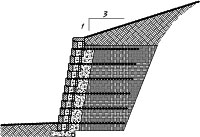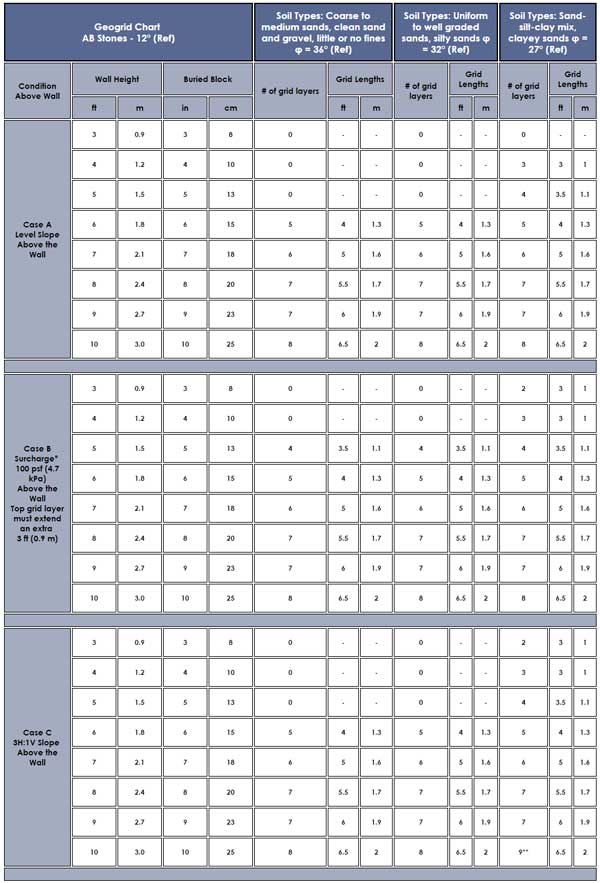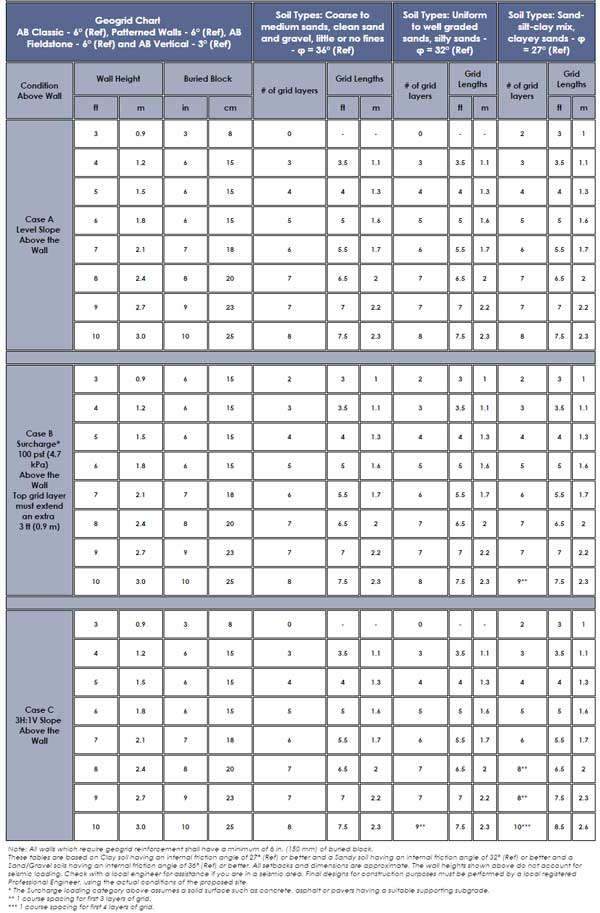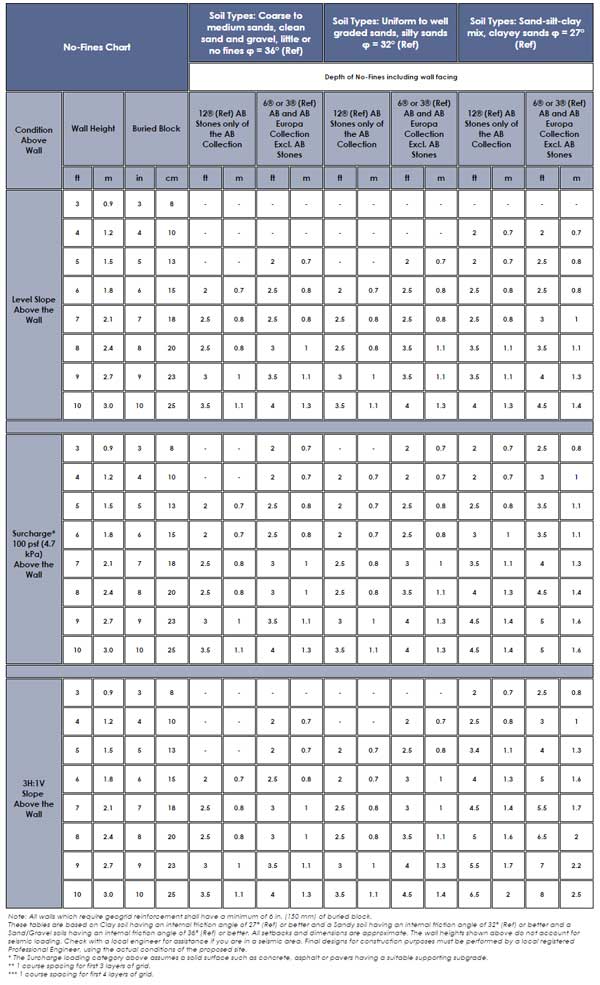Retaining Wall Geogrid and No-Fines Concrete Estimating Charts
These pre-engineered tables provide an accurate estimate for geogrid reinforcement. To use the tables, follow these simple steps:
- Verify that the site condition of your retaining wall matches the table being used.
- Verify that the soil conditions at your site match the description given.
- Choose the retaining wall height needed for your site and read across to find the number of grid layers, embedment length and grid locations.
- Verify that excessive water runoff, or a high water table, is not present.

Case A

Case B

Case C
Design Parameters
| Factors of Safety | Assumed Unit Weights | ||
| Sliding | =1.5 | Earth Backfill | = 120 lbs/ft³ (19 kN/m³) |
| Overturning | =2.0 | Filled weight of AB | = 131 lbs/ft³ (20.5 kN/m³) |
| No-Fines Overturning | =1.5 | Allan Block | = 135 lbs/ft³ (17.3 kN/m³) |
| Grid Pullout | =1.5 | No-Fines Concrete | = 110 lbs/ft³ (21.1 kN/m³) |
| Grid Rupture | =1.5 | ||
General |
Assumed Soil Capacities |
||
| Proper drainage provided. | Cohesion | = 0 | |
| Grid meets ASTM D-4595 | Bearing Capacity 36° (Ref) | ≥ 4,000 psf (191.520 kPa) | |
| Bearing Capacity 32° (Ref) | ≥ 3,500 psf (167.580 kPa) | ||
| Bearing Capacity 27° (Ref) | ≥ 2,500 psf (119.700 kPa) | ||
Grid |
|||
| Long Term Allowable Design Strength (LTADS) ≥ 700 lbs/ft. (10,200 N/m) | |||
These charts should be used for estimating grid quantities for projects which match the site and soil descriptions provided, and only for projects which use grid strengths of 700 lbs/ft. (10,200 N/m) or higher.
No provision or analysis for global stability or seismic activity are included.
The charts below assume for geogrid reinforced walls, that the reinforcement starts on the first course of block, and then every second course thereafter. The charts below are for material estimates only, contact your local engineer for wall design.
| Geogrid Chart AB Stones - 12° (Ref) |
Soil Types: Coarse to medium sands, clean sand and gravel, little or no fines φ = 36° (Ref) | Soil Types: Uniform to well graded sands, silty sands φ = 32° (Ref) | Soil Types: Sand-silt-clay mix, clayey sands φ = 27° (Ref) | ||||||||||
| Condition Above Wall | Wall Height | Buried Block | # of grid layers | Grid Lengths | # of grid layers | Grid Lengths | # of grid layers | Grid Lengths | |||||
| ft | m | in | cm | ft | m | ft | m | ft | m | ||||
| Case A Level Slope Above the Wall |
3 | 0.9 | 6 | 15 | 0 | - | - | 0 | - | - | 0 | - | - |
| 4 | 1.2 | 6 | 15 | 0 | - | - | 0 | - | - | 3 | 3 | 1 | |
| 5 | 1.5 | 6 | 15 | 0 | - | - | 0 | - | - | 4 | 3.5 | 1.1 | |
| 6 | 1.8 | 6 | 15 | 5 | 4 | 1.3 | 5 | 4 | 1.3 | 5 | 4 | 1.3 | |
| 7 | 2.1 | 7 | 18 | 6 | 5 | 1.6 | 6 | 5 | 1.6 | 6 | 5 | 1.6 | |
| 8 | 2.4 | 8 | 20 | 7 | 5.5 | 1.7 | 7 | 5.5 | 1.7 | 7 | 5.5 | 1.7 | |
| 9 | 2.7 | 9 | 23 | 7 | 6 | 1.9 | 7 | 6 | 1.9 | 7 | 6 | 1.9 | |
| 10 | 3.0 | 10 | 25 | 8 | 6.5 | 2 | 8 | 6.5 | 2 | 8 | 6.5 | 2 | |
| Case B Surcharge* 100 psf (4.7 kPa) Above the Wall Top grid layer must extend an extra 3 ft (0.9 m) |
3 | 0.9 | 3 | 8 | 0 | - | - | 0 | - | - | 2 | 3 | 1 |
| 4 | 1.2 | 4 | 10 | 0 | - | - | 0 | - | - | 3 | 3 | 1 | |
| 5 | 1.5 | 5 | 13 | 4 | 3.5 | 1.1 | 4 | 3.5 | 1.1 | 4 | 3.5 | 1.1 | |
| 6 | 1.8 | 6 | 15 | 5 | 4 | 1.3 | 5 | 4 | 1.3 | 5 | 4 | 1.3 | |
| 7 | 2.1 | 7 | 18 | 6 | 5 | 1.6 | 6 | 5 | 1.6 | 6 | 5 | 1.6 | |
| 8 | 2.4 | 8 | 20 | 7 | 5.5 | 1.7 | 7 | 5.5 | 1.7 | 7 | 5.5 | 1.7 | |
| 9 | 2.7 | 9 | 23 | 7 | 6 | 1.9 | 7 | 6 | 1.9 | 7 | 6 | 1.9 | |
| 10 | 3.0 | 10 | 25 | 8 | 6.5 | 2 | 8 | 6.5 | 2 | 8 | 6.5 | 2 | |
| Case C 3H:1V Slope Above the Wall |
3 | 0.9 | 3 | 8 | 0 | - | - | 0 | - | - | 2 | 3 | 1 |
| 4 | 1.2 | 4 | 10 | 0 | - | - | 0 | - | - | 3 | 3 | 1 | |
| 5 | 1.5 | 5 | 13 | 0 | - | - | 0 | - | - | 4 | 3.5 | 1.1 | |
| 6 | 1.8 | 6 | 15 | 5 | 4 | 1.3 | 5 | 4 | 1.3 | 5 | 4 | 1.3 | |
| 7 | 2.1 | 7 | 18 | 6 | 5 | 1.6 | 6 | 5 | 1.6 | 6 | 5 | 1.6 | |
| 8 | 2.4 | 8 | 20 | 7 | 5.5 | 1.7 | 7 | 5.5 | 1.7 | 7 | 5.5 | 1.7 | |
| 9 | 2.7 | 9 | 23 | 7 | 6 | 1.9 | 7 | 6 | 1.9 | 7 | 6 | 1.9 | |
| 10 | 3.0 | 10 | 25 | 8 | 6.5 | 2 | 8 | 6.5 | 2 | 9** | 6.5 | 2 | |
| Geogrid Chart AB Classic - 6° (Ref), Patterned Walls - 6° (Ref), AB Fieldstone - 6° (Ref) and AB Vertical - 3° (Ref) |
Soil Types: Coarse to medium sands, clean sand and gravel, little or no fines - φ = 36° (Ref) | Soil Types: Uniform to well graded sands, silty sands - φ = 32° (Ref) | Soil Types: Sand-silt-clay mix, clayey sands - φ = 27° (Ref) | ||||||||||
| Condition Above Wall | Wall Height | Buried Block | # of grid layers | Grid Lengths | # of grid layers | Grid Lengths | # of grid layers | Grid Lengths | |||||
| ft | m | in | cm | ft | m | ft | m | ft | m | ||||
| Case A Level Slope Above the Wall |
3 | 0.9 | 3 | 8 | 0 | - | - | 0 | - | - | 2 | 3 | 1 |
| 4 | 1.2 | 6 | 15 | 3 | 3.5 | 1.1 | 3 | 3.5 | 1.1 | 3 | 3.5 | 1.1 | |
| 5 | 1.5 | 6 | 15 | 4 | 4 | 1.3 | 4 | 4 | 1.3 | 4 | 4 | 1.3 | |
| 6 | 1.8 | 6 | 15 | 5 | 5 | 1.6 | 5 | 5 | 1.6 | 5 | 5 | 1.6 | |
| 7 | 2.1 | 7 | 18 | 6 | 5.5 | 1.7 | 6 | 5.5 | 1.7 | 6 | 5.5 | 1.7 | |
| 8 | 2.4 | 8 | 20 | 7 | 6.5 | 2 | 7 | 6.5 | 2 | 7 | 6.5 | 2 | |
| 9 | 2.7 | 9 | 23 | 7 | 7 | 2.2 | 7 | 7 | 2.2 | 7 | 7 | 2.2 | |
| 10 | 3.0 | 10 | 25 | 8 | 7.5 | 2.3 | 8 | 7.5 | 2.3 | 8 | 7.5 | 2.3 | |
| Case B Surcharge* 100 psf (4.7 kPa) Above the Wall Top grid layer must extend an extra 3 ft (0.9 m) |
3 | 0.9 | 6 | 15 | 2 | 3 | 1 | 2 | 3 | 1 | 2 | 3 | 1 |
| 4 | 1.2 | 6 | 15 | 3 | 3.5 | 1.1 | 3 | 3.5 | 1.1 | 3 | 3.5 | 1.1 | |
| 5 | 1.5 | 6 | 15 | 4 | 4 | 1.3 | 4 | 4 | 1.3 | 4 | 4 | 1.3 | |
| 6 | 1.8 | 6 | 15 | 5 | 5 | 1.6 | 5 | 5 | 1.6 | 5 | 5 | 1.6 | |
| 7 | 2.1 | 7 | 18 | 6 | 5.5 | 1.7 | 6 | 5.5 | 1.7 | 6 | 5.5 | 1.7 | |
| 8 | 2.4 | 8 | 20 | 7 | 6.5 | 2 | 7 | 6.5 | 2 | 7 | 6.5 | 2 | |
| 9 | 2.7 | 9 | 23 | 7 | 7 | 2.2 | 7 | 7 | 2.2 | 7 | 7 | 2.2 | |
| 10 | 3.0 | 10 | 25 | 8 | 7.5 | 2.3 | 8 | 7.5 | 2.3 | 9** | 7.5 | 2.3 | |
| Case C 3H:1V Slope Above the Wall |
3 | 0.9 | 3 | 8 | 0 | - | - | 0 | - | - | 2 | 3 | 1 |
| 4 | 1.2 | 6 | 15 | 3 | 3.5 | 1.1 | 3 | 3.5 | 1.1 | 3 | 3.5 | 1.1 | |
| 5 | 1.5 | 6 | 15 | 4 | 4 | 1.3 | 4 | 4 | 1.3 | 4 | 4 | 1.3 | |
| 6 | 1.8 | 6 | 15 | 5 | 5 | 1.6 | 5 | 5 | 1.6 | 5 | 5 | 1.6 | |
| 7 | 2.1 | 7 | 18 | 6 | 5.5 | 1.7 | 6 | 5.5 | 1.7 | 6 | 5.5 | 1.7 | |
| 8 | 2.4 | 8 | 20 | 7 | 6.5 | 2 | 7 | 6.5 | 2 | 8** | 6.5 | 2 | |
| 9 | 2.7 | 9 | 23 | 7 | 7 | 2.2 | 7 | 7 | 2.2 | 8** | 7.5 | 2.3 | |
| 10 | 3.0 | 10 | 25 | 8 | 7.5 | 2.3 | 9** | 7.5 | 2.3 | 10*** | 8.5 | 2.6 | |
| Note: All walls which require geogrid reinforcement shall have a minimum of 6 in. (150 mm) of buried block.
These tables are based on Clay soil having an internal friction angle of 27° (Ref) or better and a Sandy soil having an internal friction angle of 32° (Ref) or better and a Sand/Gravel soils having an internal friction angle of 36° (Ref) or better. All setbacks and dimensions are approximate. The wall heights shown above do not account for seismic loading. Check with a local engineer for assistance if you are in a seismic area. Final designs for construction purposes must be performed by a local registered Professional Engineer, using the actual conditions of the proposed site. * The Surcharge loading category above assumes a solid surface such as concrete, asphalt or pavers having a suitable supporting subgrade. ** 1 course spacing for first 3 layers of grid. *** 1 course spacing for first 4 layers of grid. |
|||||||||||||
| No-Fines Chart | Soil Types: Coarse to medium sands, clean sand and gravel, little or no fines φ = 36° (Ref) | Soil Types: Uniform to well graded sands, silty sands φ = 32° (Ref) | Soil Types: Sand-silt-clay mix, clayey sands φ = 27° (Ref) | |||||||||||||
| Depth of No-Fines including wall facing | ||||||||||||||||
| Condition Above Wall | Wall Height | Buried Block | 12°(Ref) AB Stones only of the AB Collection | 6° or 3° (Ref) AB and AB Europa Collection Excl. AB Stones | 12° (Ref) AB Stones only of the AB Collection | 6° or 3° (Ref) AB and AB Europa Collection Excl. AB Stones | 12° (Ref) AB Stones only of the AB Collection | 6° or 3° (Ref) AB and AB Europa Collection Excl. AB Stones | ||||||||
| ft | m | in | cm | ft | m | ft | m | ft | m | ft | m | ft | m | ft | m | |
Level Slope Above the Wall |
3 | 0.9 | 6 | 15 | - | - | - | - | - | - | - | - | - | - | - | - |
| 4 | 1.2 | 6 | 15 | - | - | - | - | - | - | - | - | 2 | 0.7 | 2 | 0.7 | |
| 5 | 1.5 | 6 | 15 | - | - | 2 | 0.7 | - | - | 2 | 0.7 | 2 | 0.7 | 2.5 | 0.8 | |
| 6 | 1.8 | 6 | 15 | 2 | 0.7 | 2.5 | 0.8 | 2 | 0.7 | 2.5 | 0.8 | 2.5 | 0.8 | 2.5 | 0.8 | |
| 7 | 2.1 | 7 | 18 | 2.5 | 0.8 | 2.5 | 0.8 | 2.5 | 0.8 | 2.5 | 0.8 | 2.5 | 0.8 | 3 | 1 | |
| 8 | 2.4 | 8 | 20 | 2.5 | 0.8 | 3 | 1 | 2.5 | 0.8 | 3.5 | 1.1 | 3.5 | 1.1 | 3.5 | 1.1 | |
| 9 | 2.7 | 9 | 23 | 3 | 1 | 3.5 | 1.1 | 3 | 1 | 3.5 | 1.1 | 3.5 | 1.1 | 4 | 1.3 | |
| 10 | 3.0 | 10 | 25 | 3.5 | 1.1 | 4 | 1.3 | 3.5 | 1.1 | 4 | 1.3 | 4 | 1.3 | 4.5 | 1.4 | |
Surcharge* 100 psf (4.7 kPa) Above the Wall |
3 | 0.9 | 3 | 8 | - | - | 2 | 0.7 | - | - | 2 | 0.7 | 2 | 0.7 | 2.5 | 0.8 |
| 4 | 1.2 | 4 | 10 | - | - | 2 | 0.7 | 2 | 0.7 | 2 | 0.7 | 2 | 0.7 | 3 | 1 | |
| 5 | 1.5 | 5 | 13 | 2 | 0.7 | 2.5 | 0.8 | 2 | 0.7 | 2.5 | 0.8 | 2.5 | 0.8 | 3.5 | 1.1 | |
| 6 | 1.8 | 6 | 15 | 2 | 0.7 | 2.5 | 0.8 | 2 | 0.7 | 2.5 | 0.8 | 3 | 1 | 3.5 | 1.1 | |
| 7 | 2.1 | 7 | 18 | 2.5 | 0.8 | 3 | 1 | 2.5 | 0.8 | 3 | 1 | 3.5 | 1.1 | 4 | 1.3 | |
| 8 | 2.4 | 8 | 20 | 2.5 | 0.8 | 3 | 1 | 2.5 | 0.8 | 3.5 | 1.1 | 4 | 1.3 | 4.5 | 1.4 | |
| 9 | 2.7 | 9 | 23 | 3 | 1 | 3.5 | 1.1 | 3 | 1 | 4 | 1.3 | 4.5 | 1.4 | 5 | 1.6 | |
| 10 | 3.0 | 10 | 25 | 3.5 | 1.1 | 4 | 1.3 | 3.5 | 1.1 | 4 | 1.3 | 4.5 | 1.4 | 5 | 1.6 | |
3H:1V Slope Above the Wall |
3 | 0.9 | 3 | 8 | - | - | - | - | - | - | - | - | 2 | 0.7 | 2.5 | 0.8 |
| 4 | 1.2 | 4 | 10 | - | - | 2 | 0.7 | - | - | 2 | 0.7 | 2.5 | 0.8 | 3 | 1 | |
| 5 | 1.5 | 5 | 13 | - | - | 2 | 0.7 | 2 | 0.7 | 2.5 | 0.8 | 3.4 | 1.1 | 4 | 1.3 | |
| 6 | 1.8 | 6 | 15 | 2 | 0.7 | 2.5 | 0.8 | 2 | 0.7 | 3 | 1 | 4 | 1.3 | 5 | 1.6 | |
| 7 | 2.1 | 7 | 18 | 2.5 | 0.8 | 3 | 1 | 2.5 | 0.8 | 3 | 1 | 4.5 | 1.4 | 5.5 | 1.7 | |
| 8 | 2.4 | 8 | 20 | 2.5 | 0.8 | 3 | 1 | 2.5 | 0.8 | 3.5 | 1.1 | 5 | 1.6 | 6.5 | 2 | |
| 9 | 2.7 | 9 | 23 | 3 | 1 | 3.5 | 1.1 | 3 | 1 | 4 | 1.3 | 5.5 | 1.7 | 7 | 2.2 | |
| 10 | 3.0 | 10 | 25 | 3.5 | 1.1 | 4 | 1.3 | 3.5 | 1.1 | 4.5 | 1.4 | 6.5 | 2 | 8 | 2.5 | |
| Note: All walls which require geogrid reinforcement shall have a minimum of 6 in. (150 mm) of buried block.
These tables are based on Clay soil having an internal friction angle of 27° (Ref) or better and a Sandy soil having an internal friction angle of 32° (Ref) or better and a Sand/Gravel soils having an internal friction angle of 36° (Ref) or better. All setbacks and dimensions are approximate. The wall heights shown above do not account for seismic loading. Check with a local engineer for assistance if you are in a seismic area. Final designs for construction purposes must be performed by a local registered Professional Engineer, using the actual conditions of the proposed site. * The Surcharge loading category above assumes a solid surface such as concrete, asphalt or pavers having a suitable supporting subgrade. ** 1 course spacing for first 3 layers of grid. *** 1 course spacing for first 4 layers of grid. |
||||||||||||||||




